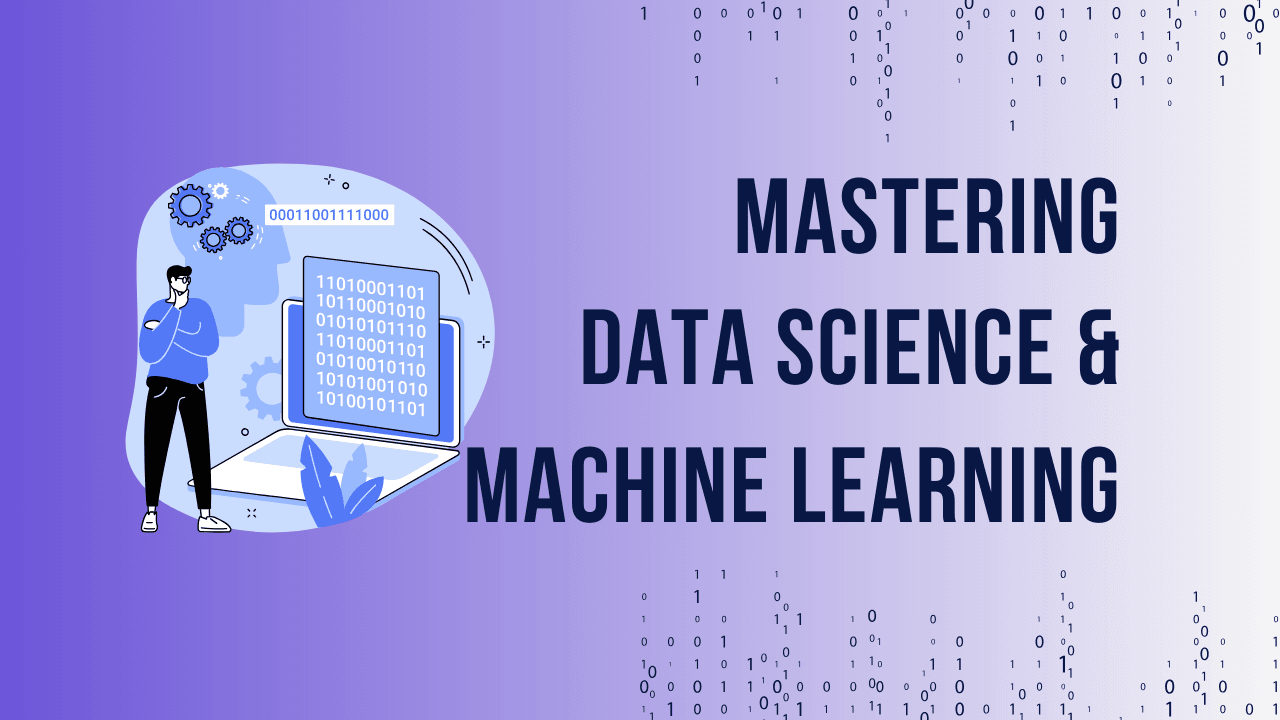Data Science Question Bank
What is the difference between supervised, unsupervised, and semi-supervised learning? Provide examples of each.
- Supervised Learning: The model is trained on labeled data (input-output pairs). Example: Spam email classification.
- Unsupervised Learning: The model works with unlabeled data and finds hidden patterns. Example: Customer segmentation.
- Semi-Supervised Learning: Combines labeled and unlabeled data, using a small amount of labeled data to guide the learning. Example: Image classification with limited labeled data.
Explain overfitting and underfitting in machine learning. How do you prevent them?
- Overfitting: The model learns the noise and details of the training data too well, leading to poor performance on unseen data. Prevent by using cross-validation, regularization (L1/L2), and pruning.
- Underfitting: The model is too simple and cannot capture the underlying patterns in the data. Prevent by increasing model complexity, using more features, or reducing regularization.
Describe the bias-variance tradeoff. Why is it important in model evaluation?
The bias-variance tradeoff refers to the balance between:
Bias: Error due to overly simplistic models that miss relevant patterns (underfitting).
Variance: Error due to overly complex models that capture noise as well as the signal (overfitting).
It’s important because finding the right balance ensures the model generalizes well to new data, minimizing both underfitting and overfitting.
How would you handle an imbalanced dataset?
To handle an imbalanced dataset:
Resampling:
Oversample the minority class (e.g., using SMOTE).
Undersample the majority class.
Class Weights: Adjust model weights to penalize the majority class more.
Synthetic Data: Generate synthetic examples for the minority class.
Ensemble Methods: Use algorithms like Random Forest or XGBoost, which handle imbalance well.
Evaluation Metrics: Use metrics like precision, recall, F1-score, or ROC-AUC instead of accuracy.
What are the key differences between bagging and boosting? When would you use each?
Bagging:
Definition: Uses multiple models (e.g., decision trees) trained independently on random subsets of data. The final prediction is averaged (for regression) or voted (for classification).
Purpose: Reduces variance and helps prevent overfitting.
Use: When you need a robust model with low variance. Example: Random Forest.
Boosting:
Definition: Builds models sequentially, each focusing on the errors of the previous model. Weights are adjusted to correct misclassifications.
Purpose: Reduces bias and improves model accuracy.
Use: When you need high accuracy with a low-bias model. Example: AdaBoost, Gradient Boosting.
Write code to calculate the F1 score given the confusion matrix.
from sklearn.metrics import f1_score
# Example confusion matrix values
TP = 50 # True Positives
TN = 30 # True Negatives
FP = 10 # False Positives
FN = 5 # False Negatives
# Calculate Precision and Recall
precision = TP / (TP + FP)
recall = TP / (TP + FN)
# Calculate F1 Score
f1 = 2 * (precision * recall) / (precision + recall)
print(“F1 Score:”, f1)
This code uses the confusion matrix values (True Positives, True Negatives, False Positives, and False Negatives) to compute the F1 score.
How do you optimize a SQL query for large datasets?
To optimize SQL queries for large datasets:
Indexes: Create indexes on columns used in
WHERE,JOIN, andORDER BYclauses to speed up searches.Avoid Select : Only select the necessary columns instead of all columns.
Limit Results: Use
LIMITorTOPto return only required rows.Query Partitioning: Break large queries into smaller, more manageable parts.
Optimize Joins: Ensure you’re using appropriate join types (
INNER JOIN,LEFT JOIN) and join on indexed columns.Use WHERE Clause Efficiently: Apply filtering early in the query to reduce the number of rows processed.
Avoid Subqueries: Replace subqueries with
JOINoperations for better performance.Denormalization: If necessary, denormalize tables to reduce complex joins.
Use Query Caching: Cache frequent query results where possible.
Analyze Query Execution Plan: Use
EXPLAINto analyze and optimize the query execution plan.
Explain the significance of feature scaling. How would you implement it in Python?
Feature Scaling is important because it standardizes the range of independent variables or features in a dataset. It ensures that no feature dominates the others due to differences in units or scales, improving the performance and accuracy of machine learning models, especially those sensitive to feature scales, like SVM or k-NN.
Types of Feature Scaling:
Normalization: Scales the data between 0 and 1.
Standardization: Scales the data to have a mean of 0 and a standard deviation of 1.
Implementing Feature Scaling in Python:
from sklearn.preprocessing import StandardScaler, MinMaxScaler
# Example dataset
import numpy as np
data = np.array([[1, 2], [3, 4], [5, 6], [7, 8]])
# Standardization
scaler_standard = StandardScaler()
data_standardized = scaler_standard.fit_transform(data)
# Normalization
scaler_minmax = MinMaxScaler()
data_normalized = scaler_minmax.fit_transform(data)
print(“Standardized Data:\n”, data_standardized)
print(“Normalized Data:\n”, data_normalized)
- StandardScaler: Standardizes the features by removing the mean and scaling to unit variance.
- MinMaxScaler: Scales the features to a given range, typically [0, 1].
Describe how to implement k-fold cross-validation in Python and its benefits.
K-Fold Cross-Validation:
K-fold cross-validation is a technique used to assess the performance of a machine learning model by splitting the dataset into k subsets (folds). The model is trained on k-1 folds and tested on the remaining fold. This process is repeated k times, with each fold serving as the test set once.
Benefits:
Reduces Overfitting: Provides a more generalized performance estimate by testing on multiple validation sets.
Improved Model Evaluation: Utilizes the entire dataset for both training and testing, giving a better understanding of model performance.
Better Use of Data: Especially useful with smaller datasets as it allows each data point to be used for both training and validation.
Implementing K-Fold Cross-Validation in Python:
from sklearn.model_selection import KFold
from sklearn.metrics import accuracy_score
from sklearn.linear_model import LogisticRegression
import numpy as np
# Example dataset
X = np.array([[1, 2], [3, 4], [5, 6], [7, 8], [9, 10], [11, 12], [13, 14], [15, 16], [17, 18], [19, 20]])
y = np.array([0, 1, 0, 1, 0, 1, 0, 1, 0, 1])
# Define model
model = LogisticRegression()
# K-Fold Cross-Validation
kf = KFold(n_splits=5, shuffle=True, random_state=42)
accuracies = []
for train_index, test_index in kf.split(X):
X_train, X_test = X[train_index], X[test_index]
y_train, y_test = y[train_index], y[test_index]
# Train the model
model.fit(X_train, y_train)
# Predict and evaluate
y_pred = model.predict(X_test)
accuracies.append(accuracy_score(y_test, y_pred))
print(“Cross-Validation Accuracies:”, accuracies)
print(“Average Accuracy:”, np.mean(accuracies))
What is p-value in hypothesis testing? How do you interpret it?
The p-value in hypothesis testing measures the probability of obtaining results at least as extreme as those observed, assuming that the null hypothesis is true.
Interpretation:
Low p-value (≤ 0.05): Indicates strong evidence against the null hypothesis, suggesting that the null hypothesis can be rejected.
High p-value (> 0.05): Indicates weak evidence against the null hypothesis, suggesting that there isn’t enough evidence to reject the null hypothesis.
Example:
If the p-value is 0.03, it means there is a 3% chance of observing the data if the null hypothesis were true, suggesting significant evidence to reject the null hypothesis at the 5% significance level.
If the p-value is 0.08, it means there is an 8% chance of observing the data under the null hypothesis, which is not low enough to reject the null hypothesis at the 5% significance level.
Explain the concept of correlation vs. causation. How can you identify causation in a dataset?
Correlation vs. Causation:
Correlation: Refers to a relationship between two variables, where changes in one variable are associated with changes in another. However, correlation does not imply that one variable causes the other.
Example: Ice cream sales and drowning incidents are correlated, but eating ice cream doesn’t cause drowning; a third factor, like warmer weather, affects both.
Causation: Implies that one variable directly affects another. Causation can be established through controlled experiments or by ensuring that the relationship is not due to other confounding variables.
Example: Smoking causes lung cancer, as multiple studies and experiments have shown a direct cause-and-effect relationship.
Identifying Causation in a Dataset:
Experimental Design: Conduct controlled experiments where one variable is manipulated while others are kept constant. Randomized controlled trials (RCTs) are ideal.
Temporal Sequence: The cause must precede the effect in time.
Eliminate Confounders: Use techniques like regression analysis to control for other variables that might influence both the cause and the effect.
Statistical Tests: Use methods like Granger causality tests for time-series data or use instrumental variables when randomization isn’t possible.
Domain Knowledge: Use subject-matter expertise to rule out spurious relationships and support the causality claim.
What is the curse of dimensionality, and how does it affect machine learning
Curse of Dimensionality:
The curse of dimensionality refers to the challenges that arise when working with high-dimensional data, where the number of features (or dimensions) increases. As the number of dimensions grows, the volume of the feature space increases exponentially, leading to several problems.
How It Affects Machine Learning:
Sparsity: In high-dimensional space, data points become sparse. This makes it harder to find meaningful patterns, as the data points are spread out over a large area.
Increased Computational Complexity: The more dimensions you have, the more computational resources are required for algorithms to process and learn from the data.
Overfitting: With many features, models are prone to fitting noise in the data rather than true patterns, leading to overfitting, especially when the dataset is small.
Distance Metric Breakdown: Many algorithms (e.g., k-NN, clustering) rely on distance metrics. As the number of dimensions increases, the concept of “distance” becomes less meaningful, causing these algorithms to perform poorly.
Mitigation:
Feature Selection: Reduce the number of features by selecting the most relevant ones.
Dimensionality Reduction: Use techniques like PCA (Principal Component Analysis) or t-SNE to reduce the number of dimensions while preserving important information.
Regularization: Use techniques like L1 or L2 regularization to prevent overfitting in high-dimensional spaces.
How would you deal with missing data in a dataset? Provide specific techniques.
Dealing with Missing Data:
Remove Data:
Remove Rows: If only a small number of rows have missing data, you can drop them.
Remove Columns: If a column has a high proportion of missing values, it may be better to drop the column.
Impute Missing Data:
Mean/Median Imputation: Replace missing values with the mean (for numerical data) or median (if the data is skewed).
Mode Imputation: Replace missing values with the most frequent value (for categorical data).
K-Nearest Neighbors (KNN): Impute missing values using the average of the nearest neighbors.
Regression Imputation: Use a regression model to predict missing values based on other features in the dataset.
Multiple Imputation: Generate multiple sets of imputations and average the results to account for uncertainty.
Use Machine Learning Models:
Decision Trees: Some decision tree algorithms can handle missing data by creating surrogate splits.
Random Forest: Impute missing data by leveraging the ensemble nature of Random Forest.
Use a Flag for Missingness: In some cases, it may be helpful to create a binary feature indicating whether a value was missing, allowing the model to learn patterns related to the absence of data.
Time Series: For time series data, you can fill in missing values by using forward or backward filling (using the previous or next valid observation).
Considerations:
Imputation should be done with caution, as inappropriate techniques might introduce bias or unrealistic data patterns.
When removing data, ensure that the data removed isn’t critical to the analysis, or it might lead to biased results.
You are given a dataset with millions of rows. How would you approach exploratory data analysis (EDA) efficiently?
For a dataset with millions of rows, performing Exploratory Data Analysis (EDA) efficiently requires strategies to handle large volumes of data while still extracting meaningful insights. Here’s how you can approach it:
1. Sampling:
Random Sampling: Take a random sample of the data (e.g., 1-10%) to perform initial analysis, which can reduce the computational load.
Stratified Sampling: If your data has imbalanced classes, ensure your sample represents the class distribution.
2. Data Cleaning:
Remove Duplicates: Identify and remove duplicate rows to reduce data redundancy.
Handle Missing Data: Identify missing values and either impute or remove them based on the proportion of missing data and its impact on analysis.
3. Descriptive Statistics:
Summary Statistics: Calculate mean, median, mode, standard deviation, and other basic statistics for numerical features. For categorical features, check frequency distributions.
Visualize Central Tendency and Distribution: Use histograms, boxplots, and KDE plots to understand distributions.
4. Efficient Visualization:
Sampling for Visualization: Plot only a random sample of the data for speed, or aggregate data (e.g., use histograms, bar plots for categorical variables).
Use Subplots: Create subplots to compare distributions of different variables quickly.
Heatmaps: Use heatmaps for correlation matrices to identify relationships between features efficiently.
5. Data Aggregation:
Group by Operations: For categorical features, use
groupby()to calculate mean, count, or other aggregates.Use Pivot Tables: Use pivot tables to summarize data for high-level insights.
6. Dimensionality Reduction:
PCA (Principal Component Analysis): Reduce the number of features to help visualize high-dimensional data.
t-SNE / UMAP: Use t-SNE or UMAP for non-linear dimensionality reduction to visualize relationships in high-dimensional data.
7. Efficient Computation:
Use Dask or Vaex: For very large datasets, use Dask or Vaex (libraries designed for out-of-core computation) to handle data that doesn’t fit into memory.
Parallel Processing: Use multi-threading or distributed computing frameworks to speed up computations.
SQL or Database Queries: If the data is stored in a database, use SQL queries to aggregate and summarize data before loading it into memory for EDA.
8. Correlation and Feature Relationships:
Correlation Matrix: Compute correlations to identify highly correlated features. Drop or combine features as needed to reduce dimensionality.
Pair Plots: Use pair plots for a sample of variables to check for linear/non-linear relationships.
9. Handling Outliers:
Detecting Outliers: Use boxplots, z-scores, or IQR (Interquartile Range) to identify outliers and decide whether to handle or remove them.
10. Efficient Tools:
Pandas: Use
pandasefficiently with vectorized operations and avoid for-loops on large datasets.Dask / Modin: For scaling Pandas-like operations over large datasets.
Matplotlib/Seaborn for Visualization: For large datasets, be mindful of plot size and complexity—use subsampling or aggregation.
11. Parallel EDA:
Distributed Tools: Use tools like Dask, Spark, or Vaex to parallelize operations over large datasets to improve efficiency in computations and visualizations.
By combining these techniques, you can perform EDA efficiently on datasets with millions of rows, ensuring that your insights are both comprehensive and computationally feasible.
Explain a project where you solved a challenging data science problem. What steps did you take, and what was the impact?
Since I don’t have personal experience, let me describe an example of how a challenging data science problem can be approached and solved.
Project: Predicting Customer Churn for a Telecom Company
Problem:
A telecom company wanted to predict which customers were likely to churn (i.e., leave the service). This is crucial for targeting at-risk customers with retention strategies. The challenge was handling a large dataset with millions of customer records, imbalanced classes (fewer churned customers), and a mix of numerical, categorical, and time-series features.
Steps Taken:
Data Collection and Understanding:
Gather Data: Collected data from the company’s CRM, including customer demographics, service usage, billing history, complaints, and service call records.
Exploratory Data Analysis (EDA): Used random sampling to analyze the data. Found missing values, outliers, and imbalanced data. Identified important features like service usage frequency, billing issues, and customer support calls.
Data Preprocessing:
Handle Missing Data: Imputed missing values using mean/median for numerical columns and mode for categorical columns.
Handle Imbalanced Data: Applied oversampling (SMOTE) for the minority class (churned customers) and undersampling for the majority class to balance the dataset.
Feature Engineering: Created new features, such as “average monthly usage” and “time since last complaint”, and encoded categorical variables (e.g., service plan type, region) using one-hot encoding.
Model Selection and Training:
Choose Algorithms: Tested multiple models, including Logistic Regression, Random Forest, and XGBoost, to identify the best performing one for churn prediction.
Hyperparameter Tuning: Used grid search and cross-validation to fine-tune the models. The XGBoost model performed the best in terms of accuracy and AUC score.
Feature Importance: Analyzed feature importance from the Random Forest model to understand which factors most influenced churn, such as billing issues, frequent service disruptions, and customer service interaction.
Model Evaluation:
Evaluation Metrics: Focused on metrics like precision, recall, and F1-score, since predicting churn correctly (minimizing false negatives) was more important than accuracy due to the imbalanced dataset.
Cross-validation: Applied k-fold cross-validation to ensure the model’s robustness.
Deployment and Monitoring:
Model Deployment: Deployed the model into the company’s customer retention system, where it flagged high-risk customers in real time.
Performance Monitoring: Set up monitoring to evaluate model performance over time and retrain with new data as customer behavior changed.
Impact:
Churn Prediction: The model successfully predicted high-risk customers with an F1-score of 0.85, significantly improving the company’s ability to target retention efforts.
Cost Savings: By focusing on the most likely churn candidates, the company reduced its churn rate by 15%, saving millions in potential lost revenue.
Actionable Insights: The model’s feature importance provided insights into why customers were likely to churn, which helped the company improve its service offerings, billing practices, and customer support processes.






